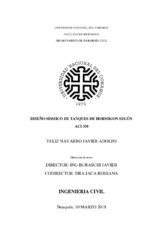- RDI Home
- →
- Facultad de Ingeniería
- →
- Trabajos Finales
- →
- View Item
JavaScript is disabled for your browser. Some features of this site may not work without it.
| dc.contributor.advisor | Buraschi, Javier | es_ES |
| dc.contributor.other | Jaca, Rossana | es_ES |
| dc.creator | Veliz Navarro, Javier Adolfo | |
| dc.date | 2018-03-10 | |
| dc.date.accessioned | 2020-03-24T20:09:18Z | |
| dc.date.available | 2020-03-24T20:09:18Z | |
| dc.identifier | http://rdi.uncoma.edu.ar/handle/uncomaid/15657 | |
| dc.description.abstract | En la región del Comahue, los tanques de almacenamiento de agua que alimentan a las redes de agua potable urbana son materializados mediante contenedores cilíndricos de hormigón armado de gran diámetro (10 a 20 m). Dependiendo de las características topográficas del área de servicio, estos tanques podrán estar directamente apoyados sobre una elevación del terreno (Bardas en el caso de Neuquén) o bien sobre-elevados mediante una estructura de elevación (zonas llanas, Cipolletti). El diseño estructural de estos elementos debe contemplar todas las acciones previstas por la normativa y, en particular, por la acción sísmica. Durante la ocurrencia de un terremoto el movimiento de las paredes genera presiones en el fluido que se adicionan a la distribución hidrostática. Para tanques de forma rectangular, estas presiones hidrodinámicas son usualmente consideradas mediante el artificio de una “masa agregada” cuya distribución responde a la solución de Westergaard. Sin embargo, su aplicación a tanques de forma circular, si bien frecuente en la práctica, no tiene sustento alguno. Por otra parte, en la normativa vigente en nuestro país este tema no es considerado particularmente, generándose un “vacío” en cuanto a los requerimientos para el diseño. Aun así, el propio cuerpo normativo CIRSOC direcciona como referencia de consulta al conjunto de documentos emitidos por el ACI que, si bien no constituyen una Norma de diseño, sus recomendaciones son recogidas por numerosos países y plasmadas en su propio cuerpo normativo. En particular, las recomendaciones para el diseño de contenedores de líquidos de hormigón armado se encuentran incorporadas en el cuaderno “Seismic Desing of Liquid-Contaigning Concrete Structures”, estándar ACI 350.3-01. Sin embargo, la aplicación del citado cuaderno no es inmediata toda vez que contiene referencias directas de aplicación en su país de origen, las cuales necesitan ser reinterpretadas y redefinidas para su utilización en el ámbito local. En síntesis, este trabajo se fundamenta en la necesidad de desarrollar análisis estructurales de tanques ajustados a las recomendaciones internacionales sobre el tema, particularmente en aquellas regiones en donde la acción sísmica resulta determinante para su diseño. | es_ES |
| dc.description.abstract | In our region, the storage tanks of water that feed the urban drinking water networks are materialized by cylindrical containers of reinforced concrete of large diameter (10 to 20 m). Depending on the topographic characteristics of the service area, these tanks may be directly supported on an elevation of the terrain (Bardas in the case of Neuquén) or over-elevated by an elevation structure (flat areas, Cipolletti). The structural design of these elements must contemplate all the actions foreseen by the regulations and, in particular, by the seismic action. During the occurrence of an earthquake the movement of the walls generates pressure in the fluid that affects the hydrostatic distribution in its interior and, particularly, in the interface with the structure. For rectangular-shaped tanks, these hydrodynamic pressures are usually considered by the artifice of an "aggregate mass" whose distribution responds to the Westergaard solution. However, its application to tanks in a circular way, although frequent in practice, has no physical support whatsoever. On the other hand, in the current regulations in force in the country, this topic is not considered particularly, generating a "vacuum" in terms of design requirements. Even so, the regulatory body itself CIRSOC addresses as reference the set of documents issued by the ACI that, while not constituting a design standard, its recommendations are collected by many countries and reflected in its own regulatory body. In particular, the recommendations for the design of reinforced concrete liquid containers are incorporated in the "Seismic Design of Liquid-Containing Concrete Structures" notebook, standard ACI 350.3-01. However, the application of the aforementioned notebook is not immediate since it contains direct references of application in its country of origin, which need to be reinterpreted and redefined for use at the local level. In summary, this work is based on the need to develop structural analysis of tanks adjusted to international recommendations on the subject, particularly in those regions where seismic action is decisive for its design. | |
| dc.format | application/pdf | es_ES |
| dc.language | spa | es_ES |
| dc.publisher | Universidad Nacional del Comahue. Facultad de Ingeniería | es_ES |
| dc.rights | Atribución-NoComercial-CompartirIgual 2.5 Argentina | es_ES |
| dc.rights.uri | https://creativecommons.org/licenses/by-nc-sa/2.5/ar/ | es_ES |
| dc.subject | Tanques de hormigón | es_ES |
| dc.subject | Diseño sísmico | es_ES |
| dc.subject | ACI 350 | es_ES |
| dc.subject.other | Ciencias Aplicadas | es_ES |
| dc.title | Diseño sísmico de tanques de hormigón según ACI 350 | es_ES |
| dc.type | trabajo final de grado | es |
| dc.type | bachelorThesis | eu |
| dc.type | acceptedVersion | eu |
| unco.tesis.grado | Ingeniero Civil | es_ES |
| dc.description.fil | Fil: Veliz Navarro, Javier Adolfo. Universidad Nacional del Comahue. Facultad de Ingeniería. Departamento de Ingeniería Civil; Argentina. | es_ES |
| dc.cole | Trabajos Finales | es_ES |



